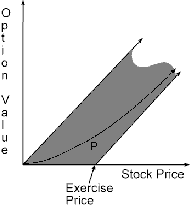 The OPTION.lng Model
The OPTION.lng ModelBlack & Scholes Options Pricing
View the model
Download the model
A call option is a financial instrument that gives the holder the right to buy one share of a stock at a given price (the exercise price) on or before some specified expiration date. A frequent question is, "How much should one be willing to pay for such an option?" We can easily come up with some broad bounds on what we would be willing to pay.
Suppose the stock price is $105 and we have a chance to buy an option with an exercise price of $100. We should certainly be willing to pay up to $5 for the option, because, as a minimum, we could buy the stock for $100 and immediately sell it for $105, realizing a profit of $5. Thus, when the stock price exceeds the exercise price, we should be willing to pay at least the difference in the two prices.
When the exercise price exceeds the stock price, buying at the exercise price and selling at the market price would not be an intelligent option. In this instance, we should be willing to "pay" at leas $0.
In any case, the most we would ever be willing to pay for an option is the current price of the underlying stock. Suppose the option price was more than the stock price. Then, we could get the same expected return at a lower price by buying the stock.
The following graphic illustrates these bound on an option's value as a function of the price of the underlying stock.

In this model, you believe that the stock of National Semiconductor(symbol: NSM) is about to go up. To capitalize on this belief, you would like to purchase call options on NSM. Checking the quotes on NSM options with your online brokerage service, you find that NSM call options are trading at 6 5/8 per share. These call options have an exercise price of $40, and expire in 133 days from today. The current price of NSM shares is 40 3/4. Are the options trading at a fair price?
Keywords:
Black & Scholes | Break Even Point | Derivatives | Financial | Financial | Option Pricing | Options | Portfolio | Sales | Uncertainty | Accounting | Banking